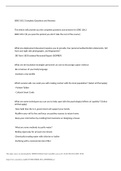Fayetteville Technical Community College
Latest uploads at Fayetteville Technical Community College. Looking for notes at Fayetteville Technical Community College? We have lots of notes, study guides and study notes available for your school.
-
80
- 0
-
4
All courses for Fayetteville Technical Community College
Latest notes & summaries Fayetteville Technical Community College
Question 1 4 out of 4 points The modern death awareness movement, emphasizing research and writing about death-related experiences, began around __________. Selected Answer: a. the late 1950s through the early 1970s Answers: a. the late 1950s through the early 1970s b. 1985 c. the end of the 19th century d. the early 1800s e. the third decade of the 20th century • Question 2 0 out of 4 points In the allegory “The Horse on the Dining-Room Table,” the Guru advises his liste...
CHEM 131 - Great notes to learn from for studying for the test. Easy to understand and helpful.
Person etext for starting our with programming logic and design chapter 4 review questions
Anatomical terminology and organization The integumentary system (skin, hair, nails) The skeletal system (bones, joints, cartilage) The muscular system (muscles, tendons, ligaments) The nervous system (brain, spinal cord, nerves) The cardiovascular system (heart, blood vessels) The respiratory system (lungs, trachea, bronchi) The digestive system (stomach, intestines, liver, pancreas) The urinary system (kidneys, bladder, ureters) The reproductive system (male and female reproductive or...
Anatomical terminology and organization The integumentary system (skin, hair, nails) The skeletal system (bones, joints, cartilage) The muscular system (muscles, tendons, ligaments) The nervous system (brain, spinal cord, nerves) The cardiovascular system (heart, blood vessels) The respiratory system (lungs, trachea, bronchi) The digestive system (stomach, intestines, liver, pancreas) The urinary system (kidneys, bladder, ureters) The reproductive system (male and female reproductive or...
Anatomical terminology and organization The integumentary system (skin, hair, nails) The skeletal system (bones, joints, cartilage) The muscular system (muscles, tendons, ligaments) The nervous system (brain, spinal cord, nerves) The cardiovascular system (heart, blood vessels) The respiratory system (lungs, trachea, bronchi) The digestive system (stomach, intestines, liver, pancreas) The urinary system (kidneys, bladder, ureters) The reproductive system (male and female reproductive or...
Anatomical terminology and organization The integumentary system (skin, hair, nails) The skeletal system (bones, joints, cartilage) The muscular system (muscles, tendons, ligaments) The nervous system (brain, spinal cord, nerves) The cardiovascular system (heart, blood vessels) The respiratory system (lungs, trachea, bronchi) The digestive system (stomach, intestines, liver, pancreas) The urinary system (kidneys, bladder, ureters) The reproductive system (male and female reproductive or...
SERE 100.2 Complete Questions and Answers This Article will provide you the complete questions and answers for SERE 100.2 SERE 100.2 (IF you pass the pretest you don't take the rest of the course) What pre-deployment document requires you to provide, four personal authentication statements, full front and right side photographs, and fingerprints? -DD Form 1833 Isolated Personnel Report (ISOPREP) What are de-escalation strategies personnel can use to discourage captor violence -Be conscio...
SERE 100.2 Complete Questions and Answers This Article will provide you the complete questions and answers for SERE 100.2 SERE 100.2 (IF you pass the pretest you don't take the rest of the course) What pre-deployment document requires you to provide, four personal authentication statements, full front and right side photographs, and fingerprints? -DD Form 1833 Isolated Personnel Report (ISOPREP) What are de-escalation strategies personnel can use to discourage captor violence -Be conscio...
Cerebral Vascular Accident (CVA) NUR 211 2001 NUR 211 CVA Case Study










